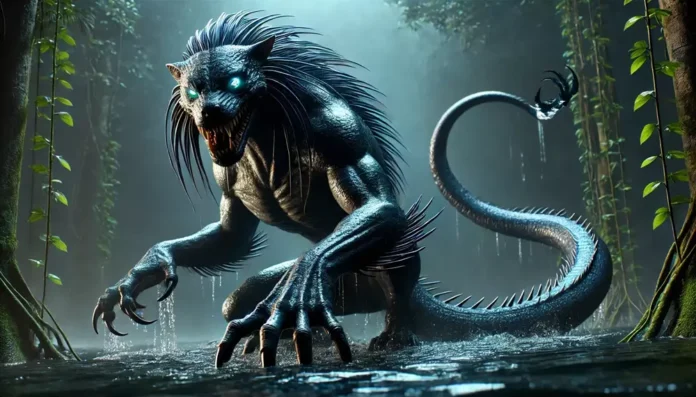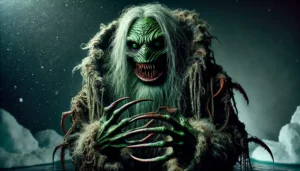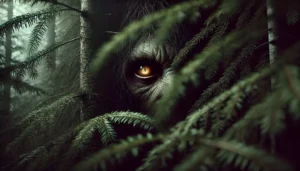Intro/Summary
Imagine standing by a lake, the water so calm it reflects the sky. Suddenly, you hear a baby crying from the reeds. You step closer, heart racing, and that’s when it strikes. The Ahuizotl—a creature as mysterious as it is terrifying—emerges. With sleek fur and a hand-tipped tail, it drags you underwater, never to surface again.
This creature from Aztec mythology wasn’t just a monster. It was a symbol, a warning about nature’s hidden dangers. The Ahuizotl represents water’s duality: life-sustaining and life-taking, all at once. Its legend teaches respect for natural forces and the price of ignorance.
History/Origin
The Ahuizotl’s story begins in the Aztec world, a civilization deeply connected to water. The Aztecs saw water as sacred, necessary for survival but capable of destruction. The Ahuizotl embodied this duality, both a guardian of water and a force of death.
Found in ancient texts like the Florentine Codex, the Ahuizotl was described as a creature lurking in lakes and rivers. It wasn’t a mere predator; it was an extension of Tlaloc, the Aztec rain god. The creature didn’t just take lives randomly—its victims were offerings, chosen to join Tlaloc’s paradise.
“The āhuitzotl dwells in the waters; there it seizes the men, drowning them as its prey, presenting them to the gods.” (Florentine Codex, Book 11: Earthly Things)
The Ahuizotl wasn’t just feared; it was revered. This blending of terror and respect shaped its place in Aztec life.
Name Meaning
The name “āhuitzotl” in Nahuatl translates roughly to “spiny aquatic thing” or “water dog.” This name tells you two things: it’s dangerous (spiny) and tied to water (aquatic). But why “dog”? The creature’s size and some canine-like features led to comparisons with dogs. Despite this, its unique tail-hand set it apart from any real animal.
Appearance
The Ahuizotl’s appearance was as chilling as its legend. Most descriptions depict it as dog-like, with sleek, black fur that glistened when wet. Its eyes shone eerily, reflecting light in the darkness. But the most haunting detail? Its tail.
The creature’s tail ended in a human-like hand, a grotesque feature used to drag victims underwater. This tail-hand gave the Ahuizotl an almost supernatural efficiency, snatching prey before they even realized the danger.
Some depictions add more fearsome details, like thorny spines along its back, emphasizing its predatory nature. The creature wasn’t just a physical threat; it was a visual nightmare.
Background Story
Legends of the Ahuizotl often start with a cry. Mimicking the sound of a baby or a distressed human, it lured people to the water’s edge. This wasn’t random. The Ahuizotl targeted those it believed were trespassing on sacred waters.
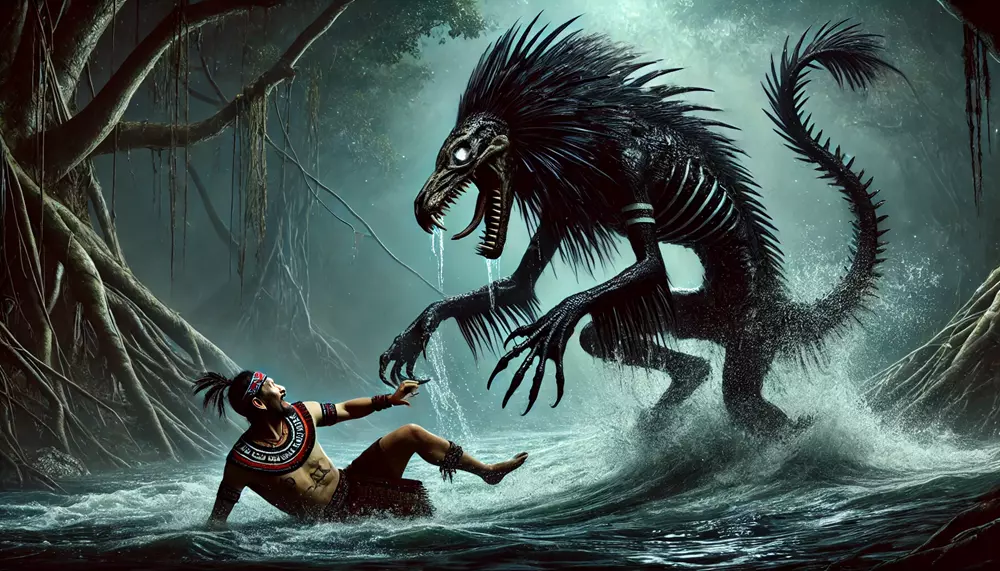
Once its victim was close, the creature struck. Using its tail-hand, it dragged them into the depths. The bodies were said to resurface later, missing their eyes, nails, and teeth. These were taken as offerings to Tlaloc, the rain god.
“Be wary of the lakes,” Aztec elders warned, “for the Ahuizotl chooses not with malice but with purpose.”
The legend wasn’t just about fear; it was a story about boundaries—nature’s and humanity’s. Trespassing on sacred waters came with a price.
Cultural Impact
For the Aztecs, the Ahuizotl wasn’t just a scary story. It was a cultural symbol. Water was vital to their survival, and the Ahuizotl reminded them of its dangers. Its legend enforced respect for natural resources and boundaries.
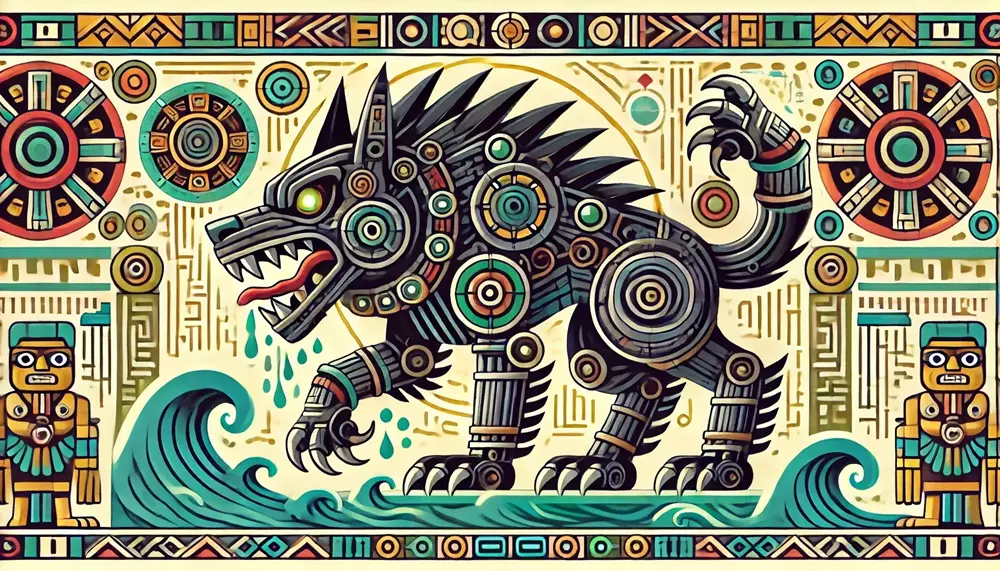
Parents used tales of the Ahuizotl to warn children against playing near water. Priests invoked its name during rituals, emphasizing its connection to the gods. Even warriors saw the creature as a reminder of nature’s unpredictable power.
Its image appeared in Aztec art, from carvings to codices, showcasing its importance. The Ahuizotl wasn’t just a myth; it was part of the fabric of Aztec life.
Similar Beasts
The Ahuizotl isn’t alone in mythology. Many cultures have water-based predators with similar themes:
Kelpie (Scotland): Like the Ahuizotl, the Kelpie lures victims to their watery doom. Its ability to shape-shift and deceive mirrors the Aztec beast’s mimicking cries. Both symbolize water’s dangers while warning against hubris.
Underwater Panther (Native American Myth): This creature guards lakes and rivers, punishing those who disrespect water. Its role as a guardian aligns closely with the Ahuizotl, showing how cultures personify natural forces.
Rusalka (Slavic Folklore): A vengeful water spirit, the Rusalka drags humans to their deaths. Both it and the Ahuizotl emphasize water’s capacity for vengeance and its link to the supernatural.
Religion/Ritual
The Ahuizotl’s ties to Tlaloc made it a spiritual figure. Victims claimed by the beast were considered chosen, destined for Tlaloc’s paradise. This belief elevated the creature from predator to divine agent.
During rain rituals, priests invoked the Ahuizotl, asking it to deliver offerings to Tlaloc. These ceremonies emphasized harmony with water, balancing gratitude and caution. The Ahuizotl wasn’t just a monster; it was part of a spiritual ecosystem.
One ritual chant reads:
“Oh Tlaloc, may the āhuitzotl carry our gifts, may it guard your waters and sustain your blessings.”
Scientific or Rational Explanations
Could the Ahuizotl have been a real animal? Some scholars think so. The creature’s traits—sleek fur, aquatic habitat, and dexterous limbs—match those of river otters or water opossums. Both are native to the region and capable of behaviors that might inspire myth.
Others suggest the Ahuizotl was a way to explain drownings or disappearances near water. By attributing these to a supernatural being, the Aztecs added a layer of respect and caution to natural dangers.
Modern Cultural References
The Ahuizotl’s legend hasn’t faded. It’s found a place in modern media, blending its ancient roots with contemporary storytelling:
Literature:
The Dark is Rising by Susan Cooper: The Ahuizotl is described as a “water demon” that attempts to drown the protagonist.
Video Games:
Assassin’s Creed: Brotherhood: The Ahuizotl appears as a type of enemy, integrating Aztec mythology into the game’s narrative.
Television:
My Little Pony: Friendship is Magic, Ahuizotl is portrayed as a villain guarding treasure in the Daring Do adventures. This character draws inspiration from Aztec mythology, incorporating the beast’s predatory traits and sinister role in storytelling
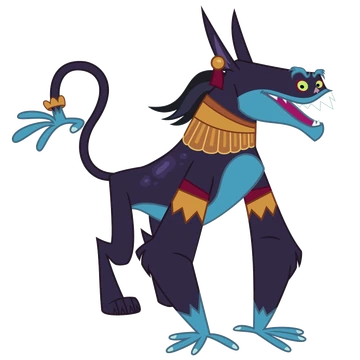
The Batman (Animated Series): The Ahuizotl is portrayed as a monster residing in Gotham City’s sewers, adding a mythological element to the series.
Pokémon Series: the creature Ambipom draws inspiration from the Ahuizotl’s tail-hand, reflecting its mythological roots.
Conclusion
The Ahuizotl is more than a legend. It’s a symbol of water’s dual nature—life-giving and deadly. From ancient Aztec rituals to modern pop culture, its story resonates, reminding us of nature’s beauty and its dangers.
“Lurking in shadowed waters, the Ahuizotl waits, not as a monster but as a guardian.”

